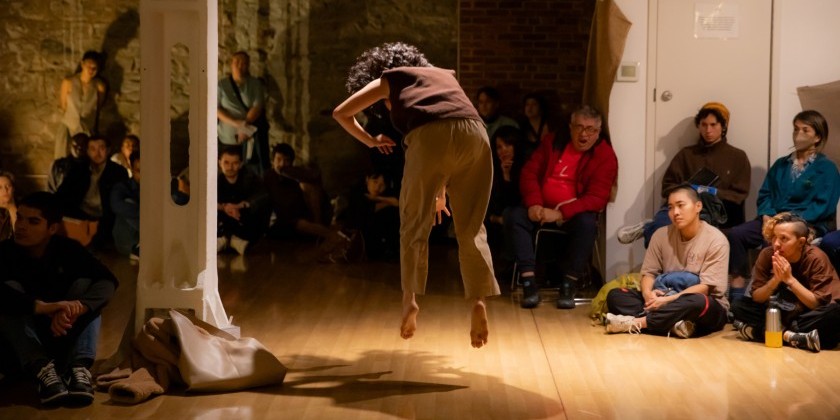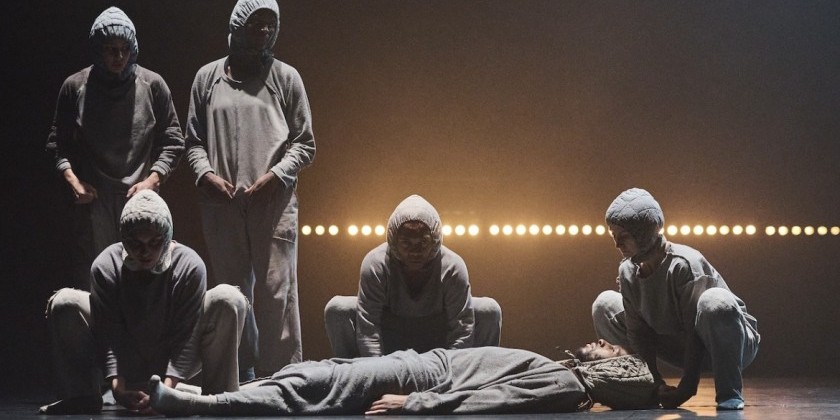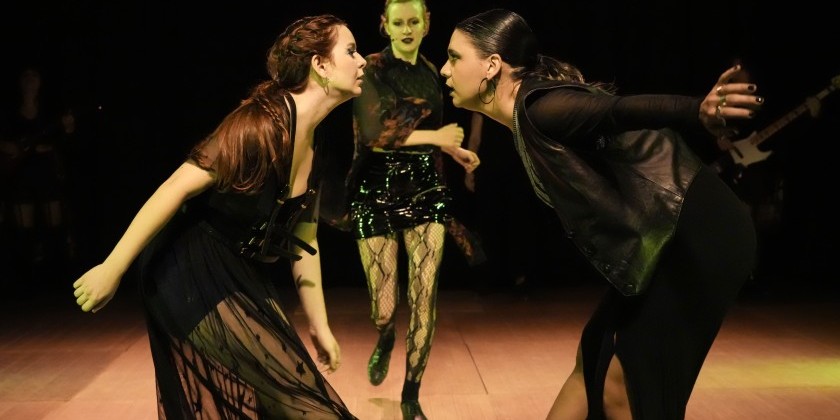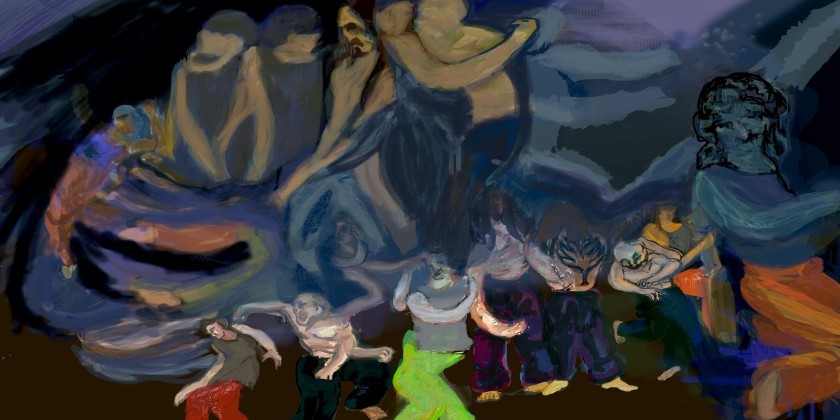AUDIENCE REVIEW: "Oracle" by Periapsis Music and Dance

Company:
Periapsis Music and Dance
Performance Date:
May 11, 2019
In the four works presented in Oracle by Periapsis Music and Dance, the dancers bring a depth of character and intention to the choreography that is missing from many dance pieces today, which are often too movement-oriented or too cerebral. While the mission of Periapsis is to foster collaboration between music and dance, all four pieces also expertly blended elements of dance and theater to create a rich experience.
First on the program, conjuring MAEJHH (by guest choreographer Annalee Traylor) exists in a world that is enclosed, stifling, almost claustrophobic. With the back curtains drawn and the trio of dancers (Erin Dillon, Elisabeth Jeffrey, and Hannah Weber) in formal black gowns, there is no color on stage. Even the music (by guest composer Hilary Purrington, performed by Jonathan Howard Katz on the piano) is stark and sparse. The piece draws heavily from the archetype of the crone, with the dancers’ grotesque movements, hunched shoulders, trembling hands, little gremlin hops and backwards skitters, directly contrasting the costumes’ formal elegance. At times they explode into a frenzy, as though possessed. Though they inhabit different characters, each with distinct quirks and intentions, the most interesting aspect of the piece is the relationship between them. They lean on, carry, or outright manipulate each other. Sometimes two band up against the other. Like sisters, even if they don’t necessarily like each other, they are forced to stick with each other in this enclosed, claustrophobic world.
Elle ne m’aime pas (choreographed by Hannah Weber) is the most theatrical piece of the program and Erin Dillon leans into the drama of the role beautifully. A microphone stands front and center while the rest of the stage is filled out by a side table and several lamps. The piano, instead of being shoved in the corner, is prominently featured, and Dillon leans on it, holding a glass of wine as she waits. The pianist is late.
The piece begins humorously. The pianist (Katz) plays an introduction. Dillon takes a breath, as though about to sing, and instead takes a sip of wine. Later, she hands Katz the glass and has him pour the wine into her mouth. Eventually she begins dancing through the space, giving a drunken bravura performance, at times even stepping up to the microphone to sing excerpts from Carmen, Samson et Dalila, and Tosca. Throughout it all she holds the wine glass.
Then she walks towards Katz and pulls him up to dance with him. As the focus of the piece transitions from the relationship between Dillon and the wine to the relationship between Dillon and Katz, the tone shifts from being humorous to finding the intimacy and vulnerability between these two characters. The performative aspect of Dillon’s character is stripped away. Her movement becomes quieter and we zero in on small details--her fingers walking down her leg, her toe slowly curving towards the floor in the moment right before it makes contact. In contrast to the operatic singing from the first half, the piece ends with her softly humming along with Katz’s piano. They sit together in an embrace, facing away from the audience.
Encaged (choreographed by Dillon, performed by Emily Wolfe), although less theatrical than the former pieces, draws us deep into the dancer’s psyche through the repetition, transformation and fragmentation of specific movements. The piece begins with Wolfe, in a crop top and jeans, facing upstage, shifting her weight side to side while her arms swing as though conducting an orchestra. Then her body jerks, assuming different positions like a marionette. Two pointer fingers placed in opposite corners pull her in different directions, limbs automatically snap into a series of ballet port de bras; we see these movements over and over, facing forward or back, on the floor, appearing unexpectedly from a different phrase or fragmented and aborted halfway through, as though they are happening of their own accord, against her will. With each repetition, not only the orientation of the movement but also the performance changes, reflecting how even as these default patterns stay the same, the character and her relationship to them changes.
In Oracle, the only piece with more of Periapsis ensemble, it becomes clear that the dancers have been working together and have developed strong relationships with each other, and Oracle mines these relationships without becoming purely character or story-driven. In duets and trios, the dancers exhilarate in the movement, each bringing their unique approach to Norbert de la Cruz III's choreography while staying connected to and relating with each other. At one point, two dancers, gesticulating wildly and arguing with an unseen figure, walk backwards from opposite sides of the stage until they cross paths and meet face to face in the middle, completing the conversation. Elsewhere, dancers feed through the holes created by other dancers or wrap around their negative space, creating a larger whole. While movement plays a big part in the piece, it never loses sight of the individual dancers at the heart of it.
In contrast, One Breath (choreographed by Amy Marshall), one of the two Periapsis Open Series guest works on Friday night, focused almost entirely on movement. One Breath begins with the dancers in a clump performing simple flowing gestures reminiscent of tai chi--directing energy and breath. All of a sudden it explodes. Dance phrases drop in and out of the space and patterns and formations take shape before your eyes before quickly moving on, like watching a cell multiply in fast forward. The choreography is less about the intention behind specific movements as it is about the constant state of movement; similarly the dancers are less individual people as they are particles.
The other guest work of the evening was eyespot (choreographed by Abdul Latif), which tries to fuse multiple elements--ballet steps with an “urban-contemporary” sensibility, choral music overlaid with cello overlaid with beat boxing, a shape shifting eye projected in the back and glittery black unitards for the two men in the trio. Of these elements, the costuming and the movement were the most successful, simultaneously intricate and bold, but performed without the same depth brought by the Periapsis dancers. The other aspects felt underdeveloped, seeds of thoughts placed next to each other without being in conversation with each other, and the result ended up being less than the sum of the whole.
Author:
Glenna Yu
Photo Credit:
Dancer Erin Dillon and pianist Jonathan Howard Katz, photo by Andrew Fassbender for Rachel Neville Photography











